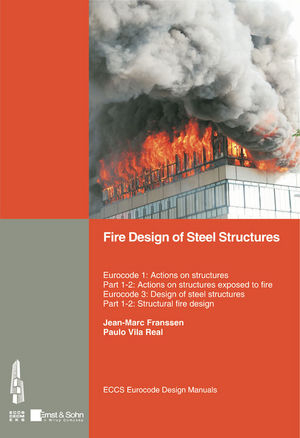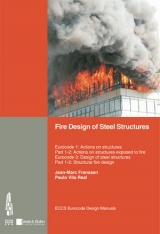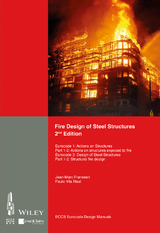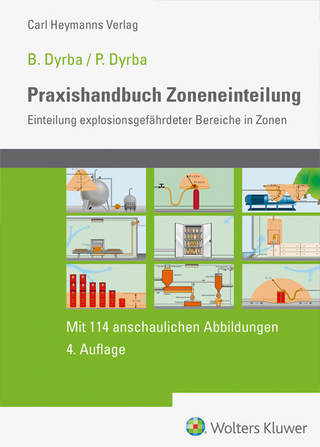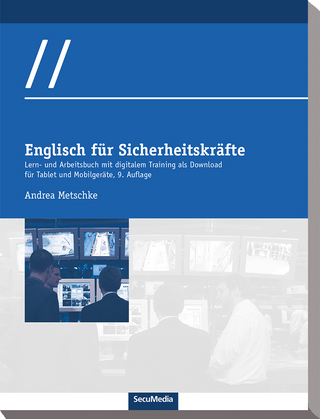Fire Design of Steel Structures
Ernst, Wilhelm & Sohn (Verlag)
978-3-433-02974-9 (ISBN)
- Titel erscheint in neuer Auflage
- Artikel merken
Dieses Buch erläutert und beschreibt die Eurocode-Normen im Hinblick auf die Bemessung und Konstruktion von Stahlbauten für den Brandfall. Nach einem einleitenden Kapitel wird in Kapitel 2 die Bemessung von mechanischen Einwirkungen (Lasten) im Brandfall nach EN 1990 und EN 1991 erklärt. Kapitel 3 beschäftigt sich mit den Modellen, die zur Darstellung der durch Feuer hervorgerufenen thermischen Lasten herangezogen werden. Die Kapitel 4 und 5 beschreiben zum einen die Verfahren zur Bemessung der Temperatur von Stahlwerken als Folge der Temperaturgegebenheiten im Brandabschnitt und zum anderen die Bestimmung der Lastaufnahme von Stahlkonstruktionen anhand der Regeln der Norm EN 193-1-2. Die Verfahren zur Bewertung der Feuerfestigkeit von Schraub- und Schweißverbindungen werden in Kapitel 7 beleuchtet. In Kapitel 8 wird das Computerprogramm "Elefir-EN" dargestellt, das auf dem einfachen Berechnungsmodell des Eurocodes beruht und es Planern ermöglicht, das Verhalten von Stahlbauteilen im Brandfall schnell und präzise zu berechnen. Kapitel 9 befasst sich mit den Fragen und Problemen, die bei der Beurteilung der Feuerfestigkeit eines ganzen Gebäudes auftreten können. Dieser Themenkomplex wird mithilfe einer Fallstudie behandelt, wobei in früheren Kapiteln eingeführte Konzepte wieder aufgegriffen werden. Die in den Eurocodes beschriebenen Konzepte und Brandschutzverfahren mögen für Ingenieure, die eher mit Vorschriften vertraut sind, komplex erscheinen. Dieses Buch betrachtet den Planungs- und Konstruktionsprozess in seiner logischen Abfolge, gibt praktische und nützliche Hilfestellung und verwendet ausführliche Beispiele, mit denen sich die Vorteile des neuen Brandschutzansatzes in jeder Hinsicht erschließen.
Jean-Marc Franssen is Professor at the Department of Architecture, Geology, Environment and Construction of the University of Liege in Belgium. He is leading the group of fire safety engineering and is the Director of the Fire Resistance Laboratory. He is a member of the Technical Committee TC3 - Fire of ECCS. He founded the Structures in Fire (SiF) movement of which he is teh chairman of the Steering Committee. He was a member of the draft team of EN 1993-1-2 Paulo Vila Real is Professor at the Dep. of Civil Engineering of the University of Aveiro in Portugal where he is the Director of the Fire Resistance Laboratory. He is a member of the Technical Committee TC3- Fire of ECCS and of the Steering Committee of the Structures in Fire (SiF) movement. In Portugal he is a member of the Technical Committee CT 115- Eurocodes where he was in charge of writing the National Annexes to the fire parts of the Eurocodes on actions, concrete, steel, composite and aluminium structures.
Jean-Marc Franssen ist Professor im Fachbereich Architektur, Geologie, Umwelt und Bau der Universität Liège in Belgien. Er ist Leiter der Fachgruppe Brandschutztechnik und Direktor des Labors für Brandschutz. Auch gehört er dem technischen Ausschuss TC3 "Fire" der EKS an. Professor Franssen ist ebenfalls Initiator der Bewegung "Structures in Fire (SiF)" und Vorsitzender dessen Lenkungsausschusses. Er war ebenfalls Mitglied der Normenarbeitsgruppe zu EN 1993-1-2. Paulo Vila Real ist Professor im Fachbereich Bauingenieurswesen der Universität Aveiro, Portugal und Direktor des dortigen Labors für Brandschutz. Er gehört dem technischen Ausschuss TC3 "Fire" der EKS und dem Lenkungsausschuss der Bewegung "Structures in Fire (SiF)" an. In Portugal ist er Mitglied des technischen Ausschusses CT 115 "Eurocodes" und erarbeitete die nationalen Dokumente zu den Brandschutzregeln der Eurocodes in den Bereichen Lasteinwirkungen, Beton-, Stahl-, Verbund- und Aluminiumtragwerke.
INTRODUCTION
Relations between different Eurocodes
Scope of EN 1993-1-2
MECHANICAL LOADING
General
Examples
Indirect actions
THERMAL ACTION
Nominal temperature-time curves
Parametric temperature-time curves
Zone models;
CFD models
Localized fires
External members
TEMPERATURE IN STEEL SECTIONS
The heat conduction equation and its boundary conditions
Advanced calculation model. Finite element solution of the heat conduction equation
Section factor
Temperature of unprotected steelwork exposed to fire
Temperature of protected steelwork exposed to fire
Internal steelwork in a void protected by heat screens
External steelwork
Example
View factors in the concave part of a steel profile
Temperature in steel members subjected to localized fires
Temperature in stainless steel members
Example
MECHANICAL ANALYSIS
Basic principles 99
Mechanical properties of carbon steel 104
Classification of cross-sections 109
Fire resistance of structural members 118
Tension members;
Compression members;
Shear resistance;
Laterally restrained beams;
Laterally unrestrained beams;
Members with Class 1, 2 or 3 cross-sections, subjected to combined bending and axial compression;
Members with Class 4 cross-sections;
Some verifications of the fire resistance not covered by EN 1993-1-2
Design in the temperature domain. Critical temperature
Design of continuous beams
Fire resistance of structural stainless steel members
Design examples
ADVANCED CALCULATION MODELS
Thermal response model
Mechanical response model
JOINTS
Strength of bolts and welds at elevated temperature
Temperature of joints in fire
Bolted connections
Design fire resistance of welds
Design examples
THE COMPUTER PROGRAM "ELEFIR-EN"
Brief description of the program
Default constants used in the program
Design example
CASE STUDY
Fire resistance under standard fire
Thermal calculations
Structural calculation
Fire resistance under natural fire
Temperature development in the compartment
REFERENCES
ANNEX A THERMAL DATA FOR CARBON STEEL AND STAINLESS STEEL SECTIONS
A.1. Thermal properties of carbon steel
A.2. Section factor Am /
V [m-1] for unprotected steel members
A.3. Section factor Ap /
V [m-1] for protected steel members
A.4. Tables and nomograms for evaluating the temperature in unprotected steel members subjected to the standard fire curve ISO 834
A.5. Tables and nomograms for evaluating the temperature in protected steel members subjected to the standard fire curve ISO 834
A.6. Thermal properties of some fire protection materials
A.7. Thermal properties of stainless steel
A.7.1. Specific heat
A.7.2. Thermal conductivity
A.7.3. Thermal elongation
A.8. Tables and nomograms for evaluating the temperature in unprotected stainless steel members subjected to the standard fire curve ISO 834
A.9. Thermal properties of some fire compartment lining materials
ANNEX B INPUT DATA FOR NATURAL FIRE MODELS
B.1. Introduction
B.2. Fire load density
B.3. Rate of heat release density
B.4. Ventilation control
B.5. Flash-over
ANNEX C MECHANICAL PROPERTIES OF CARBON STEEL AND STAINLESS STEEL
C.1 Mechanical properties of carbon steel
C.1.1. Mechanical properties of carbon steel at room temperature (20ºC)
C.1.2. Stress-strain relationship for carbon steel at elevated temperatures (without strain-hardening)
C.1.3. Stress-strain relationship for carbon steel at elevated temperatures (with strain-hardening)
C.1.4. Mechanical properties to be used with Class 4 cross-section and simple calculation models
C.2. Mechanical properties of stainless steel
ANNEX D TABLES FOR SECTION CLASSIFICATION AND EFFECTIVE WIDTH EVALUATION
ANNEX E SECTION FACTORS OF EUROPEAN HOT ROLLED IPE AND HE PROFILES
ANNEX F CROSS-SECTIONAL CLASSIFICATION OF EUROPEAN HOT ROLLED IPE AND HE PROFILES
F.1. Cross-sectional classification for pure compression and pure bending
F.2. Cross-sectional classification for combined, compression and bending moment
| Erscheint lt. Verlag | 28.6.2010 |
|---|---|
| Sprache | englisch |
| Maße | 170 x 240 mm |
| Gewicht | 994 g |
| Themenwelt | Technik |
| Schlagworte | Bauingenieur- u. Bauwesen • Brandschutz • Brückenbau • Civil Engineering & Construction • Civil Engineering & Construction • EC • EUROCODE • Eurocode (EC) • Feuerfesttechnik • Fire Protection • Hochbau • Stahlbau • Stahlhochbau u. Brückenbau • Steel Construction & Bridge Engineering • Steel Construction & Bridge Engineering |
| ISBN-10 | 3-433-02974-1 / 3433029741 |
| ISBN-13 | 978-3-433-02974-9 / 9783433029749 |
| Zustand | Neuware |
| Informationen gemäß Produktsicherheitsverordnung (GPSR) | |
| Haben Sie eine Frage zum Produkt? |
aus dem Bereich
